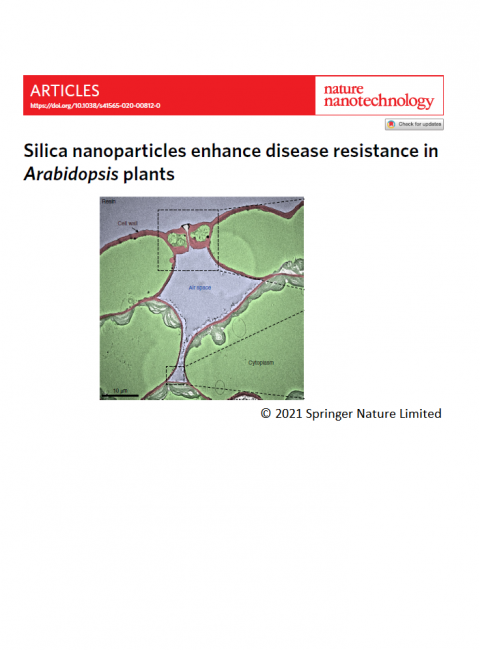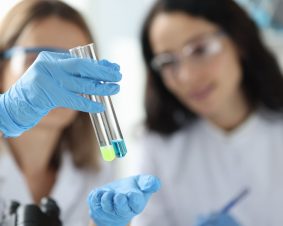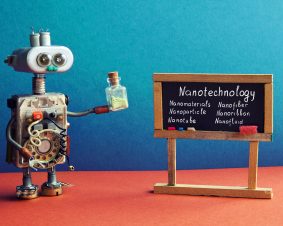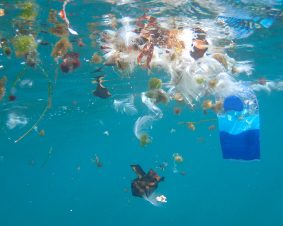 >
Spotlight December 2021: Silica nanoparticles improve plant disease resistance
>
Spotlight December 2021: Silica nanoparticles improve plant disease resistance
The resistance of plants to various pathogens is often increased in agriculture with various chemicals (“fertilizers”). A new direction is being taken with the use of nanoparticles. These can be sprayed on the plants. In the present study, the model plant Arabidopsis was used to investigate whether silicon dioxide nanoparticles (SiO2) can increase resistance to bacteria. For this purpose, plants were pretreated with silicon dioxide nanoparticles and then infected with bacteria. The plant hormone salicylic acid plays a major role in the defense against pathogens in plants. It is also used in human medicine as an antipyretic drug. Therefore, the content of salicylic acid in Arabidopsis leaves provided information about the protective function of silicon dioxide nanoparticles.
First of all, an uptake of the silicon dioxide nanoparticles via the pores of the leaves could be proven. Subsequently, a slow release of (ortho)silicic acid [Si(OH)4] occurs inside the leaves. (Ortho)silicic acid finally leads to the increased formation of salicylic acid by the plant, to which the actual protection against bacterial infections can be attributed. This shows that the administration of silicon dioxide nanoparticles was safer for the plant than the direct administration of (ortho)silicic acid. This is because the direct application of (ortho)silicic acid resulted in cellular stress responses, which were also visible by yellow leaves. In contrast, silicon dioxide nanoparticles in high concentrations showed no toxic effect, because the release of the effective (ortho)silicic acid is slow (depot effect). Only very small amounts of nanoparticulate silica are needed to exert a protective effect on the plant, making it a more cost-effective alternative comparing to other substances.
The authors caution that despite the beneficial properties of silicon dioxide nanoparticles for plant health, the long-term effects on farm workers, soil microorganisms and bees also need to be studied. Previous results with nematodes indicate a 36-fold lower toxicity of the nanoparticles, compared to liquid (ortho)silica. Thus, silica nanoparticles may be a safe and sustainable chemical for protection against plant diseases.
Original publication:
El-Shetehy M., Moradi A., Maceroni M., et al. Silica nanoparticles enhance disease resistance in Arabidopsis plants. Nat Nanotechnol. 2021;16(3):344-353. doi:10.1038/s41565-020-00812-0
More info on silica nanoparticles in our material text.

Weitere Spotlights
Spotlight September 2023: Fishing for raw materials with proteins
The so-called rare earth elements such as neodymium, dysprosium or cerium are elements that are of great importance for the energy transition; among others they serve as components of magnets in generators for electric power generation, act as luminescent materials in energy-saving lamps or as part of the car exhaust catalytic converter. The global production […]
Read moreSpotlight January 2022: Methods, models, mechanisms and metadata
For the new year, we are presenting no “classic” paper here, but would like to point out an editorial: Methods, Models, Mechanisms and Metadata: Introduction to the Nanotoxicology Collection at F1000 Research. This editorial introduces the F1000Research Nanotoxicology Collection, where best practices can be collected in the form of original research reports, including no-effect studies, […]
Read moreSpotlight November 2023: Early Awareness and Action System for Advanced Materials (Early4AdMa)
Advanced materials hold immense potential to address global challenges such as environmental degradation, transformation of the energy sector, and development towards circularity. To harness their benefits while ensuring safety and sustainability, regulatory bodies, scientific communities, and industries have recognized the need for proactive approaches. The “Early4AdMa” system is a pre-regulatory risk governance tool for advanced […]
Read moreSpotlight July: Plastic Pollution and the Urgent Need for Comprehensive Action
Plastic pollution has become a significant threat to the oceans, biodiversity, and ecosystems worldwide. Despite efforts to reduce plastic consumption, escalating plastic production continues to increase the magnitude of plastic pollution in the environment. In response to this crisis, the UN-Environmental Assembly (Link) adopted a resolution in March 2022 to develop a legally binding treaty […]
Read more


